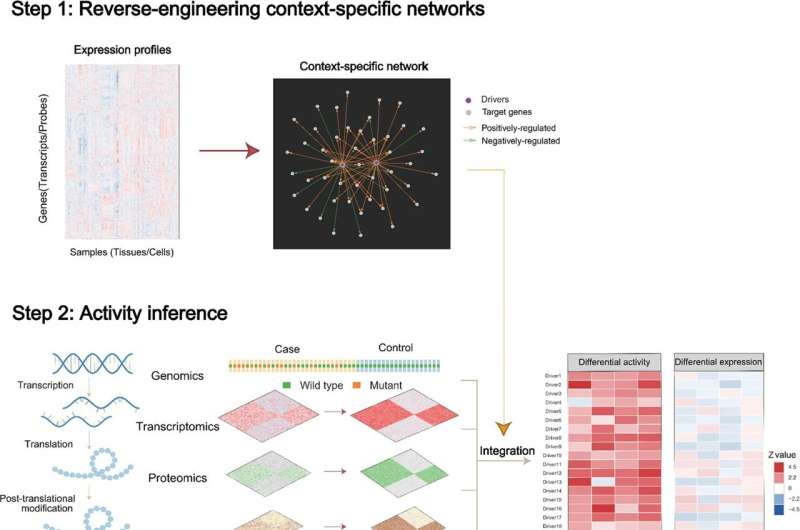This article has been reviewed according to Science X's editorial process and policies. Editors have highlighted the following attributes while ensuring the content's credibility:
fact-checked
peer-reviewed publication
trusted source
proofread
Upgraded computational tool gets more out of multi-omics data

Despite the astounding advances made in understanding the biologic underpinnings of cancer, many cancers are missing obvious genetic drivers. When scientists can't pinpoint the factors that drive cancer, treating it can be much more difficult.
Scientists at St. Jude Children's Research Hospital hope to solve that problem with an updated way to analyze multi-omic (primarily transcriptomics and proteomics) data. The researchers created a next-generation computational tool to gain new insights from biological data and find hidden druggable targets. The tool's capabilities were published in Nature Communications today.
The updated application, NetBID2, successfully uncovers difficult-to-identify proteins that drive biological processes (such as rapid cell growth) contributing to cancer. These hidden drivers present new therapeutic opportunities, either because existing drugs can already target them or because they might inspire drug developers to make new therapeutics.
"We made it easier to find hidden drivers," said corresponding author Jiyang Yu, Ph.D., St. Jude Department of Computational Biology. "Finding hidden drivers is important because many of these are potentially druggable targets. NetBID2 can find these drivers and potentially move them quickly into clinical trials. We may be able to re-purpose an already FDA-approved drug that targets an identified hidden driver to a completely different patient population that may benefit."
A network approach to finding hidden drivers
Large sets of RNA sequencing data from specific cells or cancer types can contain valuable information necessary to find hidden drivers of disease; however, standard analysis tools struggle to find them. NetBID2 is a sequel to the original tool developed by Yu in 2018. He specifically designed these tools to find hidden drivers by squeezing out more from "big data."
"NetBID2 enables us to maximize the data we have," said Yu, "particularly RNA sequencing data. It goes beyond the traditional mutation or differential gene expression data to expose hidden events and information that may be functionally important."
Hidden drivers cannot be discovered by conventional genomics or sequencing approaches because their activity depends on post-translational modifications and other mechanisms that are invisible to traditional sequencing but affect the expression of other genes.
Therefore, NetBID2 takes RNA sequencing data, then generates a gene-gene interactome. This interactome tracks the relationships between driver candidates and their downstream effector genes to determine which signaling proteins are most central to the key relationships that fuel disease. These "central hubs" directing the network are the hidden drivers.
"NetBID2 looks for a hidden driver like the FBI would look for a crime boss," Yu said.
"If you look at the suspect, there's no direct evidence to connect them with any crime. The way to capture them is first to build a network of associates. We do the same when we build the biological network by collecting a lot of data on its members and their relationships. Then we look for the boss's first neighbors in the network when we look at a hidden driver's activity. That's the only way to capture the boss—by inference from their activities—otherwise, there is no way to identify them. We find these hidden drivers' guilt by association."
As proof of the tool's capabilities, the St. Jude group showed it could find biologically meaningful hidden drivers in three unrelated samples. Using NetBID2, the team found unappreciated roles for MYC in adult lung cancer and for NOTCH1 in difficult-to-treat pediatric leukemia that standard differential expression analysis at the mRNA or protein levels hadn't uncovered, despite the genes' having been previously linked to cancer.
They also found an unappreciated role for Gabpa in normal immune cell function. The gene's importance was context-specific in each case, highlighting the need for targeted analyses.
The software's other capabilities, such as new visualization tools, are meant to facilitate further analysis and discovery of hidden drivers from complex networks of RNA-seq and, in some cases, proteomics data.
NetBID2 is freely available on a GitHub repository. The St. Jude Cloud, which includes a NetBID2 app and data from many multi-omics projects, is also freely available for other scientists to use for further discovery of hidden drivers of basic biology and disease.
More information: Xinran Dong et al, NetBID2 provides comprehensive hidden driver analysis, Nature Communications (2023). DOI: 10.1038/s41467-023-38335-6




















